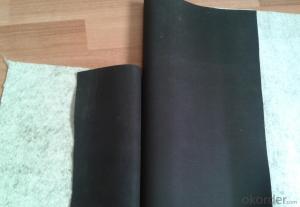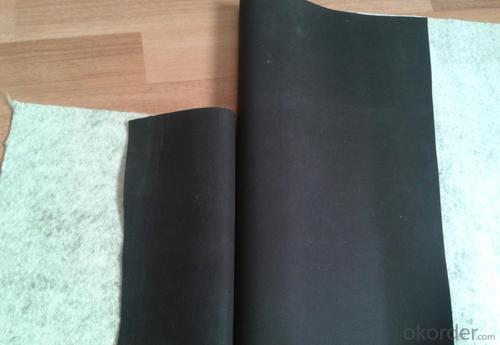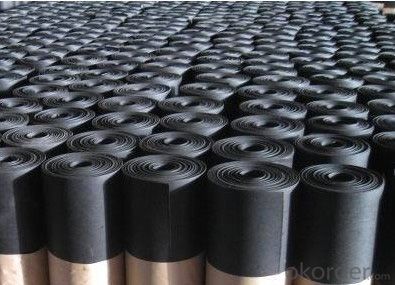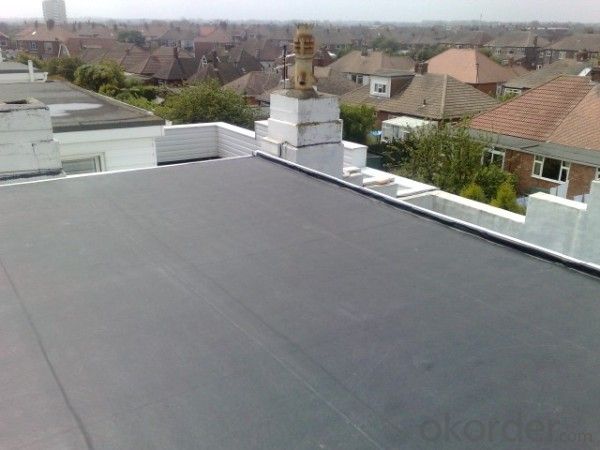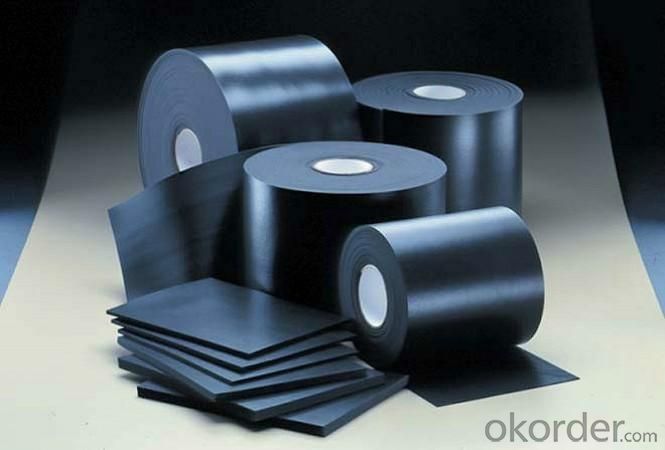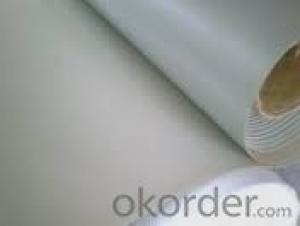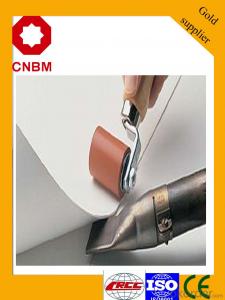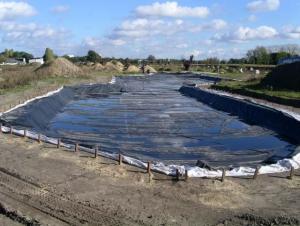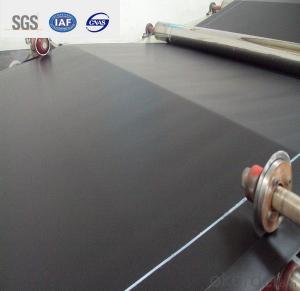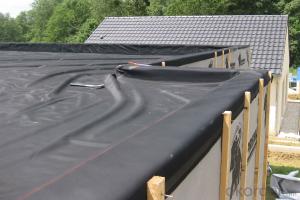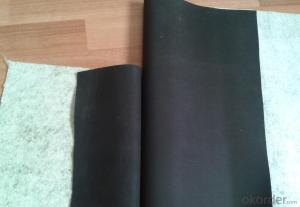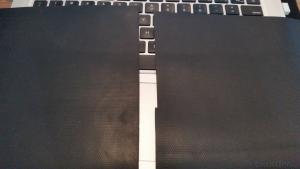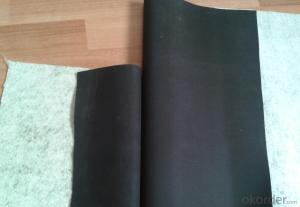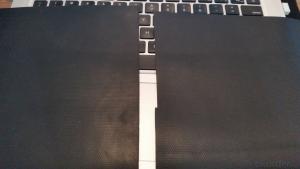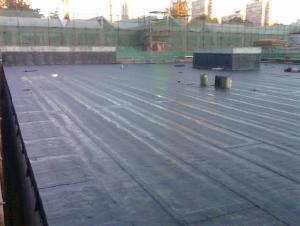EPDM Rubber Material Waterproof Membrane with Fleeced Back
- Loading Port:
- Shanghai
- Payment Terms:
- TT OR LC
- Min Order Qty:
- 50000 m²
- Supply Capability:
- 5000000 m²/month
OKorder Service Pledge
OKorder Financial Service
You Might Also Like
EPDM Rubber Material Waterproof Membrane with Fleeced Back
Description Of EPDM Rubber Material Waterproof Membrane with Fleeced Back:
This waterproof coiled material is of high elasticity with best performance among high polumer waterproof coiled material in the world.It is also the most typical one in the world.Waterproof coiled material made of ternary ethylene-propylene rubber is produced with the use of the most advanced contiuous extrusion and vulcanization technology and related equipments which are specially designed for production of such product.It is good in compactness,without bubble and performance difference in length and breadth,perfomances reach or exceed the demands of GB18173.1-2000 standard.
Main Features of EPDM Rubber Material Waterproof Membrane with Fleeced Back:
1.EPDM waterproof membrane for bridge engineering waterproof
2.EPDM waterproof membrane for water conservancy projects ,such as river bank,lake dam seepage.
3.EPDM waterproof membrane for the municipal engineering.
4.EPDM waterproof membrane for aquaculture.
Specifications of EPDM Rubber Material Waterproof Membrane with Fleeced Back:
| Number | Item | Unit | Value | |
| 1 | Size Variation | Thichness | % | ±10 |
| Width | % | ±1 | ||
| Length | % | Allowed negative | ||
| 2 | Breaking tensile strength at normal temperature | Mpa | ≥7.5 | |
| Breaking tensile strength at 70°C | Mpa | ≥2.3 | ||
| 3 | Breaking elongation at normal temperature | % | ≥450 | |
| Breaking elongation at -20°C | % | ≥200 | ||
| 4 | Tear strength | KN/m | ≥25 | |
| 5 | Impermeability(30min) | * | 0.3Mpa no leakage | |
| 6 | Bending at low tempreture | °C | ≤-40 | |
| 7 | Stretch tensor at heating | Elongate | mm | ≤2 |
| Shrink | mm | ≤4 | ||
| 8 | Air oven aging(80°C×168h) | Tensile strength at break retained | % | ≥80 |
| Elongation at break retained | % | ≥70 | ||
| 9 | Anti-alkali | Tensile strength at break retained | % | ≥80 |
| Elongation at break retained | % | ≥80 | ||
| 10 | Nuture weathing at manual simulation | Tensile strength at break retained | % | ≥80 |
| Elongation at break retained | % | ≥70 | ||
Applications of EPDM Rubber Material Waterproof Membrane with Fleeced Back:
Widely used in roofs, basement, toilet ,swimming pool, and all kinds of industry and civil building waterproofing, reservoir, vivicism, bridge, underground, tunnel and dam waterproofing ,especially to the keystone waterproofing projects which is durability, high corrosion resistance and easy deformation.



IMages of EPDM Rubber Material Waterproof Membrane with Fleeced Back:




FAQ of EPDM Rubber Material Waterproof Membrane with Fleeced Back:
1. What are we supplying?
We are specialized in producing Colorful Asphalt Roof Shingle, SBS/APP modified bitumen waterproof membrane, Self adhesive bitumen waterproof membrane, PVC waterproofing membrane, EPDM rubber roofing membrane, Single Component Polyurethane Waterproof Coating, and Spray Polyurea Waterproof Coating
.
2. How Many years experience do we have?
We have been exported to more than 20 countries in the past 15 years.
3. How long do we usually reply your request?
We always reply our customer within 24 hours.
- Q: Can a waterproofing membrane be used on concrete walls?
- Concrete walls can benefit from the use of a waterproofing membrane. These membranes are specifically designed to prevent water from penetrating the surface and can be applied to various surfaces, including concrete walls. Common materials used for these membranes include modified bitumen, rubberized asphalt, and synthetic polymers, all of which are highly resistant to water and moisture. By applying a waterproofing membrane to concrete walls, one can effectively prevent water seepage, dampness, and potential damage caused by water infiltration. The membrane acts as a protective barrier, stopping water from permeating through the concrete and reaching the interior spaces. Additionally, it helps maintain the structural integrity of the concrete by reducing the risks of cracks, efflorescence, and other forms of moisture-related deterioration. There are several types of waterproofing membranes available in the market, such as sheet membranes, liquid membranes, and cementitious coatings. The choice of the membrane depends on factors such as the specific application, the degree of water exposure, and the condition of the concrete wall. It is essential to select a membrane that is compatible with the concrete and provides long-lasting waterproofing protection. Before applying the membrane, it is crucial to properly prepare the concrete surface. This involves tasks such as cleaning, repairing any cracks or imperfections, and ensuring that the surface is dry and free from contaminants. The membrane is then installed according to the manufacturer's instructions, which usually involves adhering it to the concrete or applying a liquid membrane with a brush or roller. To sum up, a waterproofing membrane is a valuable solution for protecting concrete walls from water infiltration. By choosing the right type of membrane and following proper installation procedures, one can effectively preserve the durability and longevity of the concrete while safeguarding the interior spaces from potential water damage.
- Q: How does a waterproofing membrane handle construction joints?
- Construction applications require the use of a waterproofing membrane to prevent water from penetrating the structure. Specifically, in concrete structures where construction joints are commonly found, the membrane is engineered to effectively address these areas. During the construction process, joints are created to allow for movement between different sections of the structure. Unfortunately, these joints can also be vulnerable points where water can potentially infiltrate. To tackle this concern, waterproofing membranes are installed to ensure that these joints remain watertight. Different methods are employed to handle construction joints with waterproofing membranes. One popular approach is to directly apply the membrane over the joint, extending it beyond the joint edges. This creates a continuous waterproof layer that covers both the joint and its adjoining areas. Another technique involves the use of specially designed joint tapes or strips that are embedded within the membrane. These tapes or strips, typically made of materials like rubber or PVC, are placed directly over the joint before the membrane is applied. They serve as an additional layer of protection, enhancing the waterproofing performance of the membrane at the joint. Additionally, there are specialized waterproofing systems available that include pre-formed joint sealants. These sealants are designed to fit snugly into the joint, providing a tight seal against water intrusion. The membrane is then installed over the joint, ensuring comprehensive waterproofing coverage. In summary, a waterproofing membrane is specifically engineered to effectively handle construction joints by offering a durable and efficient barrier against water penetration. Whether through extending the membrane over the joint, utilizing joint tapes or strips, or incorporating pre-formed joint sealants, these membranes guarantee that construction joints remain watertight, thus safeguarding the structure from potential water damage.
- Q: Can a waterproofing membrane be used for plant rooms and mechanical equipment areas?
- Plant rooms and mechanical equipment areas can benefit from the use of a waterproofing membrane. It is necessary to waterproof these areas in order to safeguard the equipment and surrounding structures against water damage. A waterproofing membrane serves as a commonly implemented solution for this purpose. By forming a barrier, it effectively prevents water infiltration into the plant rooms and mechanical equipment areas, thereby ensuring the equipment remains dry and protected. Moreover, this membrane aids in averting moisture-related problems like the growth of mold and mildew, which can be detrimental to both the equipment's functionality and the overall operation of the plant room. Ultimately, incorporating a waterproofing membrane in plant rooms and mechanical equipment areas proves to be a dependable and efficacious approach for maintaining the longevity and performance of the equipment and structures.
- Q: Can a waterproofing membrane be used in ponds or reservoirs?
- Yes, a waterproofing membrane can be used in ponds or reservoirs. These membranes are specifically designed to provide a barrier against water, preventing leaks and seepage. They are commonly used in various water containment applications, including ponds, reservoirs, and other water storage structures. Waterproofing membranes are typically made of durable materials such as rubber, PVC, or HDPE (high-density polyethylene). They are resistant to UV radiation, chemicals, and other environmental factors that can degrade the integrity of the membrane. This ensures long-lasting protection and prevents water from seeping through the structure. The installation of a waterproofing membrane in a pond or reservoir involves careful preparation of the surface, followed by the application of the membrane using appropriate adhesives or welding techniques. The membrane is typically applied to the entire surface area, including the walls and the base of the structure, to ensure complete water tightness. Using a waterproofing membrane in ponds or reservoirs offers several advantages. It helps to maintain the water level by preventing evaporation and leakage. This is especially important in arid regions where water scarcity is a concern. Additionally, it helps to protect the surrounding soil from water contamination and prevents the loss of valuable water resources. However, it is important to note that the selection of the appropriate waterproofing membrane should be based on the specific requirements of the pond or reservoir. Factors such as the size of the structure, the type of water it will contain, and the environmental conditions should be considered when choosing the right membrane. In conclusion, a waterproofing membrane can indeed be used in ponds or reservoirs to provide a reliable and long-lasting solution for water containment and prevention of leaks. With proper installation and maintenance, it can ensure the integrity and sustainability of the water storage structure.
- Q: Can a waterproofing membrane be used on both interior and exterior surfaces?
- Yes, a waterproofing membrane can be used on both interior and exterior surfaces. Waterproofing membranes are designed to protect surfaces from water penetration and damage. They are typically made of materials such as rubber, asphalt, or thermoplastic, which provide a barrier against moisture. Whether it is applied on interior walls, floors, or exterior foundations, roofs, or balconies, a waterproofing membrane can effectively prevent water from seeping through and causing potential issues like leaks, mold, or structural damage. It is important to consider the specific requirements of each surface and choose a waterproofing membrane that is suitable for the intended application.
- Q: How to choose waterproof membrane
- Fourth, the product price comparison Waterproof membrane products, intense competition, fake rampant to the production market, the largest amount of SBS modified asphalt waterproofing membrane, for example, the best profits are super but 15%. On the market there are many high-priced SBS modified asphalt waterproofing membrane, the SBS content is very small, even without SBS, with waste rubber powder to replace. Therefore, when buying, try to avoid the selection of products significantly lower than the market price.
- Q: How does a waterproofing membrane handle joint or crack movements?
- A waterproofing membrane is designed to handle joint or crack movements by being flexible and elastic. It is constructed using materials that can stretch and move with the underlying structure, allowing for expansion and contraction without compromising the watertight seal. This flexibility ensures that the membrane can accommodate any movements in the joints or cracks, preventing water from seeping through and causing damage. Additionally, some waterproofing membranes have added features such as reinforcement or bridging capabilities, which further enhance their ability to handle joint or crack movements. Overall, a waterproofing membrane is specifically engineered to effectively seal and protect against water intrusion while accommodating any movements in the joints or cracks of a structure.
- Q: Why is the top cover of the basement waterproofing? While the floor has to empty shop?
- Basement waterproof construction specification. Basement waterproofing acceptance specification.
- Q: Can a waterproofing membrane be used for a stadium?
- Indeed, a stadium can benefit from the utilization of a waterproofing membrane. Specifically engineered to serve as a barrier against water infiltration, this membrane proves to be an optimal solution for safeguarding the structure of a stadium against any water-related damage. Its application can encompass various areas of the stadium, including the roof, walls, and foundation, effectively preventing leaks and the seepage of moisture. In addition, the implementation of a waterproofing membrane can play a crucial role in prolonging the lifespan of the stadium, shielding it from the detrimental consequences of water, such as corrosion and the growth of mold. In summary, the usage of a waterproofing membrane for a stadium represents a pragmatic and efficient approach to ensuring its durability and longevity.
- Q: Can a waterproofing membrane be used for wastewater facilities?
- Yes, a waterproofing membrane can be used for wastewater facilities. Waterproofing membranes are specifically designed to protect structures from water damage, including from wastewater. These membranes are typically made of durable materials such as PVC, EPDM, or TPO, which have excellent resistance to water and chemicals. Wastewater facilities require robust protection against the corrosive and potentially damaging effects of wastewater. Installing a waterproofing membrane can help prevent water infiltration, which can lead to structural damage, deterioration, and contamination of surrounding areas. Waterproofing membranes provide a barrier that prevents water and moisture from penetrating the facility's walls, floors, and foundations. This helps to maintain the integrity of the structure, prevent leaks, and protect against corrosion caused by chemicals present in wastewater. In addition to protecting against water and chemical damage, some waterproofing membranes also offer resistance to UV rays, high temperatures, and freeze-thaw cycles, which are important considerations for wastewater facilities located in extreme weather conditions. Overall, using a waterproofing membrane in wastewater facilities is a reliable and effective solution to ensure long-term protection against water damage, maintain the structural integrity, and enhance the durability of the facility.
Send your message to us
EPDM Rubber Material Waterproof Membrane with Fleeced Back
- Loading Port:
- Shanghai
- Payment Terms:
- TT OR LC
- Min Order Qty:
- 50000 m²
- Supply Capability:
- 5000000 m²/month
OKorder Service Pledge
OKorder Financial Service
Similar products
Hot products
Hot Searches
Related keywords
